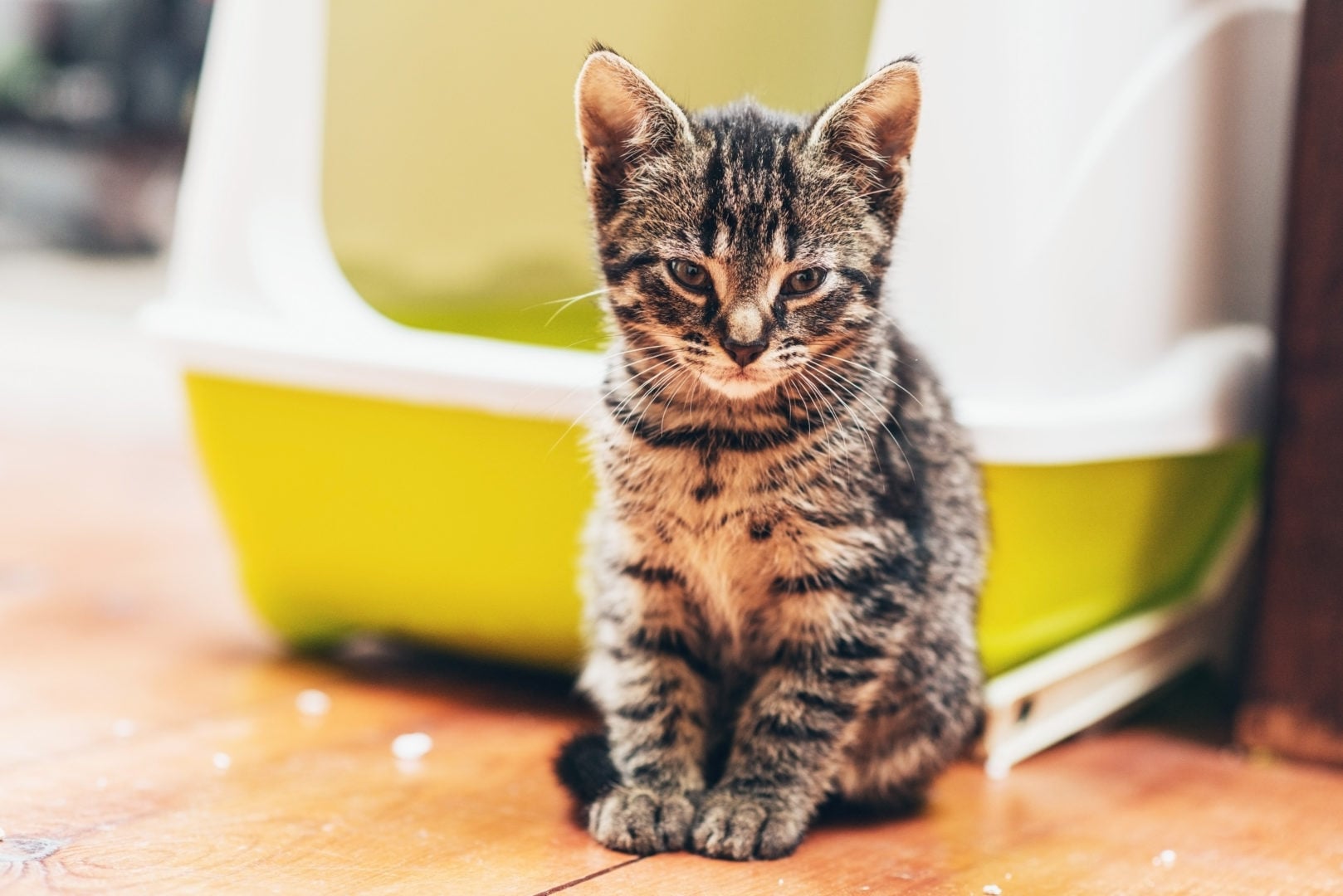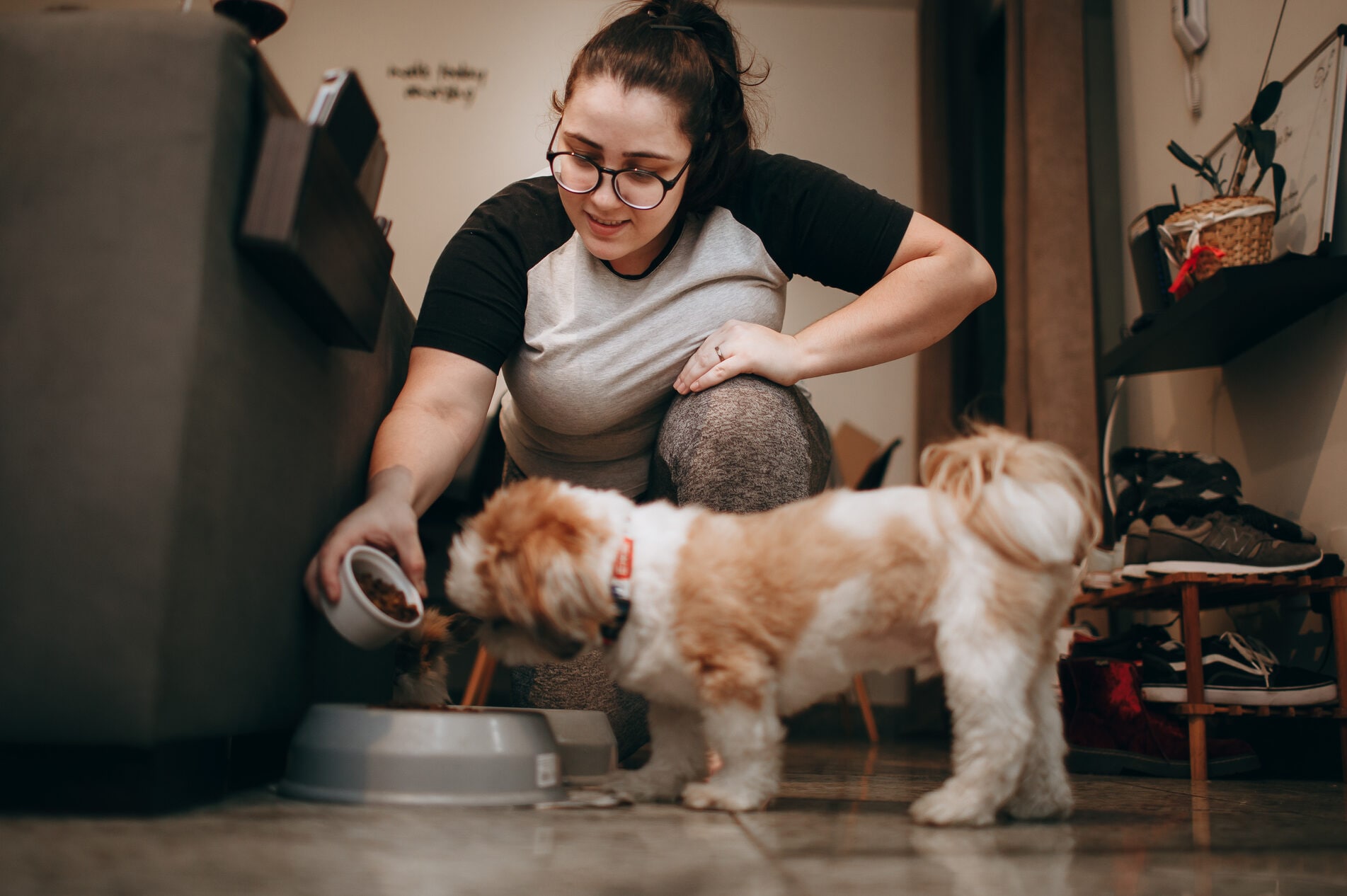Let’s face it: No matter how much we love our cats, cleaning their litter boxes is the absolute worst. The good news is that with the variety of automatic, self-cleaning litter boxes available, there’s no reason you should ever have to use a litter scoop ever again! The only bad news is that there are a TON of them, which can make it hard — and overwhelming — to choose the right one for your cat.
To help you through this process, we did a side-by-side comparison of six automatic, self-cleaning litter boxes: The PetSafe Simply Clean Automatic Litter Box; The LitterMaid LM580 Classic Self-Cleaning Litter Box; The PetSafe ScoopFree Original Self-Cleaning Litter Box; The SmartScoop Self-Scooping Litter Box; the CatGenie; and the Litter-Robot III Open Air. Not only are these six boxes the most popular options on the market right now, but they’re also the only ones currently available that are fully automated. (The rest of the models have either been discontinued, or involve the user manually scooping waste.)
Below, you’ll find a comparison chart that gives a basic overview of how each litter box stacks up against the following factors:
- Price Tag: The cost of the unit alone;
- Single- or Multi-Cat: Whether the unit is ideal for single- or multi-cat households;
- Ease of Setup: How easy or hard it is to set up the unit;
- Noise Level: The amount of noise the unit produces;
- Maintenance: The level of effort needed to clean and maintain the unit;
- Waste Disposal Frequency: The frequency with which you’ll need to empty the litter compartment;
- Odor Control: How well the unit does at minimizing odors from waste;
- Litter Scatter Control: How well the unit does at preventing litter from getting outside the box;
- Size: The dimensions of the unit in terms of length, width and height;
- Primary Power Source;
- Backup-up Power Source; and
- Special Placement Considerations: Can the unit stand on its own? Or does it need to be placed near an AC outlet, etc.?

Read the Reviews: The 6 Most Popular Automatic, Self-Cleaning Litter Box Brands
We’ve also provided you with more detailed write-ups of each litter box (arranged in order of price from lowest to highest) to help you get a better understanding of which option would work best for your cat.
1) The PetSafe Simply Clean Automatic Litter Box ($99)
How It Works: The PetSafe Simply Clean Automatic Litter Box runs on electricity and uses clumping, clay cat litter that you pour into the bowl. This bowl rotates slowly and continuously, and makes one full rotation every hour. The bowl’s slow rotation moves any litter clumps or solid waste toward a conveyor belt, which picks them up and drops them into a covered waste bin. All the owner needs to do is remove the bin and dump the waste as needed. One litter box can comfortably care for the uses of two cats.
Pros: The PetSafe Simply Clean Automatic Litter Box is the most competitively-priced litter box on this list. Not only is the upfront cost of the unit relatively inexpensive, but you won’t need to buy any additional special accessories to maintain it! The only extra items you may want to consider getting are plastic bags with which you can line the waste bin. To that point, the bin was designed specifically to fit standard-sized recyclable shopping bags, so you can reuse all the ones you collect after your weekly grocery run! This makes the PetSafe Simply Clean an ideal choice for the environment AND your wallet. The waste bin is hidden from sight, which helps minimize the odor. The unit makes no noise and has no visible moving parts, so your cat won’t be scared or spooked from using it.
Cons: The PetSafe Simply Clean Automatic Litter Box received a neutral rating for “Ease of Setup” because there is some assembly required that can be a little tricky. The unit has a weight limit of 15 pounds, so cats weighing more than that may have trouble fitting in the litter box. The sides of the unit are also shorter than those of some competitors, so you may have some trouble with cat litter scatter. Additionally, some consumer reviews on Amazon.com complained of the conveyor belt dying after a few weeks, but those complaints seem to be few and far between. There also doesn’t seem to be any back-up battery system in place, yet.
2) The LitterMaid LM580 Classic Self-Cleaning Litter Box ($113.99)
How It Works: The LitterMaid Classic Self-Cleaning Litter Box runs on electricity and uses clumping cat litter. The litter box has sensors that monitor your cat’s comings and goings, and an automatic rake is set to sweep 10 minutes after your cat leaves the box. The rake pushes any litter clumps or solid waste into a sealed, disposable receptacle at the end of the box, which the pet parent can dispose of as necessary.
Pros: The LitterMaid Classic Self-Cleaning Litter Box is almost fully assembled as-is, so all you really have to do in terms of setup is put in the waste receptacle/bag or litter tray. The unit was designed with extra high walls to help keep as much kitty litter as possible inside the box. The unit’s $113.99 price tag is fairly reasonable and includes: 4 waste receptacles; 4 carbon filters; a scoop and rake cleaner; AC adapter; and one back-up battery compartment. The back-up power source is a pro in and of itself! The carbon filters act as additional — and powerful — odor control. Both the rake and litter tray are removable to allow for easier and more thorough cleanings. This unit runs on electricity (and has a battery backup), which makes it easy to find a spot for it in your home. To top it all off? There’s no assembly required!
Cons: Although the LitterMaid brand does carry self-cleaning litter boxes specifically for multi-cat households (e.g., The Classic Mega Self-Cleaning Automatic Litter Box), this particular model is only ideal for single-cat use. Although the upfront cost of the litter box is reasonable, this unit does require the repeat purchase of additional accessories (e.g., charcoal filters, sealed receptacles, deodorizer) — in addition to cat litter — that could really add up over time. The unit’s cleaning cycles tend to be very noisy. Additionally, it’s recommended that you empty the waste compartment every few days, which some users may find tedious.
3) The PetSafe ScoopFree Original Self-Cleaning Litter Box ($129.95)
https://www.youtube.com/watch?v=fdy0QpRFO8M
How It Works: The PetSafe ScoopFree Original Self-Cleaning Litter Box runs on electricity and uses crystal litter to remove odors. All you have to do is load the litter box with a pre-filled litter tray full of crystal litter, plug it in and let it do its thing. The litter box has sensors that monitor your cat’s comings and goings, and an automatic rake is set to sweep 20 minutes after you cat leaves the box. The rake pushes any litter clumps or solid waste into a closed waste compartment. Every few weeks, you’ll just have to remove the litter tray, cover it with a lid, and dispose of it.
Pros: The PetSafe ScoopFree Original Self-Cleaning Litter Box is almost fully assembled as-is, so all you really have to do in terms of setup involves putting in the waste receptacle/bag or litter tray. You’re getting up there in price with this unit, but it’s still pretty affordable compared to other litter boxes on the market. Due to the unit’s design and use of crystal litter, you could theoretically go for weeks without having to clean or maintain it. It also reduces the amount of contact you will have with the waste itself. An added benefit of crystal litter: less dust in the house! If your cat reenters the box within 20 minutes, the rake timer will reset itself — a great safety feature in our book! This unit is great for multi-cat households, although it may mean that you need to clean it a little more frequently. Cats of any size and weight can use this unit, as well.
Cons: The most outstanding con for the ScoopFree Original Self-Cleaning Litter Box is that itrequires you to buy those pre-filled, disposable crystal litter tray refills on a regular basis. Given that you’re advised to throw them out every three weeks or so, this can — and will — add up very quickly, especially in a multi-cat household. Also, the crystal litter doesn’t do as good of a job of absorbing liquid waste and their odors. The unit’s cleaning cycles also tend to be slightly noisy, which can spook cats. The sides are pretty low, which makes it easier for your cat to scatter litter.
4) The SmartScoop Self-Scooping Litter Box ($159.99)
How It Works: The SmartScoop Self-Scooping Litter Box runs on electricity and uses generic clumping cat litter. The litter box has sensors that monitor your cat’s comings and goings, and an automatic rake is set to sweep 15 minutes after your cat leaves the box. Unlike other models, the motor unit is set on a track that run along the outside of the box, which prevents litter from clogging the gears. The waste receptacle is actually attached to the rake itself, rather than a separate compartment within the box. This means that as the rake scoops up clumps, it flips up and pops the waste into the attached bin, rather than pushing it backwards. The bin is equipped with a trademarked No-Touch Waste Bag and carbon filter that help neutralize odors. (This filter should be changed once a month in a single-cat household, and once a week for a multi-cat household.)
Pros: The SmartScoop Self-Scooping Litter Box comes to you almost fully assembled, so the only setup you need to do is install the waste receptacle/bag or litter tray. The unit’s $159.99 price tag includes 24 No-Touch Waste Bags, 6 Activated Carbon Filters, a Litter Catching Ramp and a Litter Catching Mat. The company also offers a 1-year warranty from date of purchase.The SmartScoop also takes normal clumping cat litter, so you don’t have to spend more money on special types of litter — a change that could also upset your cat in the process. And, as with the ScoopFree, the SmartScoop’s timer resets itself if your cat reenters the box within that 15-minute window.
Cons: One of the most notable downsides to the SmartScoop Self-Scooping Litter Box is that the rake doesn’t reach the opposite edge of the box when it’s cleaning. This means that any clumps that were left up against the opposite wall will remain in the box. Many owners have also complained about the level of noise the unit makes when it’s raking. Another downside is that you can’t use just any generic plastic bag to line the waste bin; you have to purchase the company’s No-Touch Waste bags. Given that the company recommends replacing these bags about once a week for single-cat households, this could really start adding up for people with multiple cats. The rake goes through a sort of catapult motion to deposit waste into the attached waste bin, which can create a decent amount of mess outside the box.
5) The CatGenie (Starts at $244)
https://www.youtube.com/watch?v=0zsWUGWGZxw
How It Works: The CatGenie is the only true “self-cleaning” automatic litter box on the market because it actually flushes waste away and sanitizes itself so you don’t have to. To that end, the CatGenie requires both an AC outlet and a plumbing hookup in order to work.
Once that’s set up, you just need to fill the bowl of the unit with non-absorbing CatGenie Washable Granules instead of normal, disposable cat litter. According to the website, these granules can be sanitized so that they “never need changing and are 100% dust free, biodegradable and septic safe.” When your cat relieves herself, any liquids she leaves behind will drain through these granules and into a sanitizing solution that kills the odors. You then have three different clean cycle settings you can choose from: you can preset it to run one to four times a day; you can manually start it by pressing the “Start” button; or, you can set it to start once your cat leaves the box. When the CatGenie’s cleaning cycle is activated, the bowl spins around so that clumps are scooped up and dumped into a bin. Then, they’re then ground up, liquefied and flushed down the drain. Once the clumps are gone, CatGenie SaniSolution is mixed with water and completely cleanses the bowl, scooper and granules. When the sanitation cycle is done, a blower dries off the granules.
Pros: The most notable and appealing pro of the CatGenie is that it really does clean itself…a feature that makes the $244+ price tag much easier to swallow. Not only does it pulverize and “flush” solid waste, but it also uses a proprietary sanitizing solution to wash and scrub the bowl AND the granules. That means you’re coming face-to-face with your cat’s litter — and waste — far less frequently than with other kitty litter boxes. And although you’ll need to buy the SaniSolution cartridges regularly, they actually last for about 120-240 washes, depending on the cleaning cycle setting you choose. Another pro is that the CatGenie uses washable, reusable granules rather than normal cat litter, which could end up saving you a lot of money later on. (One box of granules will last you about 4-6 months.)
Cons: The most notable con of the CatGenie is that it requires a connection to a cold water tap — as well as a toilet or washing machine drain — in order to completely dispose of waste. For this reason, it received the worst “Ease of Setup” rating out of the whole group. Another con is that the CatGenie is also a pretty sizable unit and makes a lot of noise during cleaning. A final con is that the CatGenie doesn’t sell its litter box unit sold on its own, so customers are provided with several “package” options from which they can choose. The Tabby Package is the most basic and “economical” of CatGenie’s offerings, but that could still be seen as pricey for many cat owners.
6) The Litter-Robot III Open Air ($449)
How It Works: The Litter-Robot III Open Air is considered to be the “first major update” to the Litter-Robot line of self-cleaning litter boxes. After the cat visits the box, the timer will count down a pre-determined time delay (you have the option of choosing a 3-, 7-, or 15-minute delay), which gives the litter enough time to clump before the automatic cleaning cycle starts. Once 7 minutes is up, the globe slowly rotates to sift through the litter and separate the clumps from the clean litter. The clumps are dropped into a carbon-filtered drawer to prevent any odors from escaping, and the globe returns itself to the “home” position. Users can empty the large drawer where the waste is deposited as needed.
Pros: The most notable pro of the Litter-Robot III Open Air is its “Drawer Full” indicator feature, which wasn’t included in any of the Open Air‘s predecessors. It’s relatively self-explanatory: When the carbon-filtered drawer becomes full with litter clumps, a blue light will flash. That way, you won’t have to guess anymore! Another pro of this box is that it gives you the ability to lock-out the control panel, which is a great feature for anyone with inquisitive pets (or kids) who have a penchant for hitting buttons. This prevents the settings or cycles from being accidentally changed — leaving you with a stinky house. A third pro of the Litter-Robot III Open Air is the adjustable cycle timer; as mentioned before, you have the option of setting the timer for 3, 7, or 15 minutes, depending on how frequently you need the litter scooped. A fourth pro is that it has an automatic night light, which will make the litter chamber glow so that cats can find it and use it more easily. (This is a great feature if you have elderly cats.) A fifth pro is that you can buy a backup battery that will last up to 48 hours if your power goes out for whatever reason. A sixth pro is that it has an 8-hour sleep mode, which is really useful if you don’t want the box going through cleaning cycles at night. The seventh pro is that it doesn’t need any special accessories to work; all you need to get is clumping kitty litter and regular kitchen garbage bags. (That’s pretty nice, given that the box alone costs about $450.)
Cons: One of the cons of the Litter-Robot III Open Air is that its cycles can be noisy (although it does have that sleep mode feature to prevent making any nighttime noise). A second (potential) con is that it’s covered, which your cats may not like — even if you do. While the unit is user-friendly, it’s high price tag means it’s not wallet-friendly.
Susan Paretts is a freelance writer and graduate of the University of Southern California. She has published articles related to pets, beauty, health, green living, interior design and gardening for a variety of publications.
*Care.com does not endorse or recommend any commercial products, processes, or services. The views and opinions of authors expressed on Care.com do not necessarily state or reflect those of Care.com, and they may not be used for advertising or product endorsement purposes.





